Holy moley, is that the most dense and snooty post title ever? I think it might be. However, I think it’s a much more interesting subject than most folks might anticipate, and it’s something that came to my attention largely as a result of shooting 2-gun matches with a couple different French rifles. So, bear with me and I think you’ll find it worthwhile!
Here in the US, rifle sights have been designed for basically high power target shooting, for pretty much as long as the US military has used metallic cartridges. The Krag and 1903 Springfield are particularly good examples of this, with front sights that are paper-thin and equally tiny rear notches to fit them in. This allows for very precise shots when the shooter is slung up and looking at a nicely contrasting target…like a black bull on a white background. Here’s what these sort of sights look like from the shooter’s perspective:
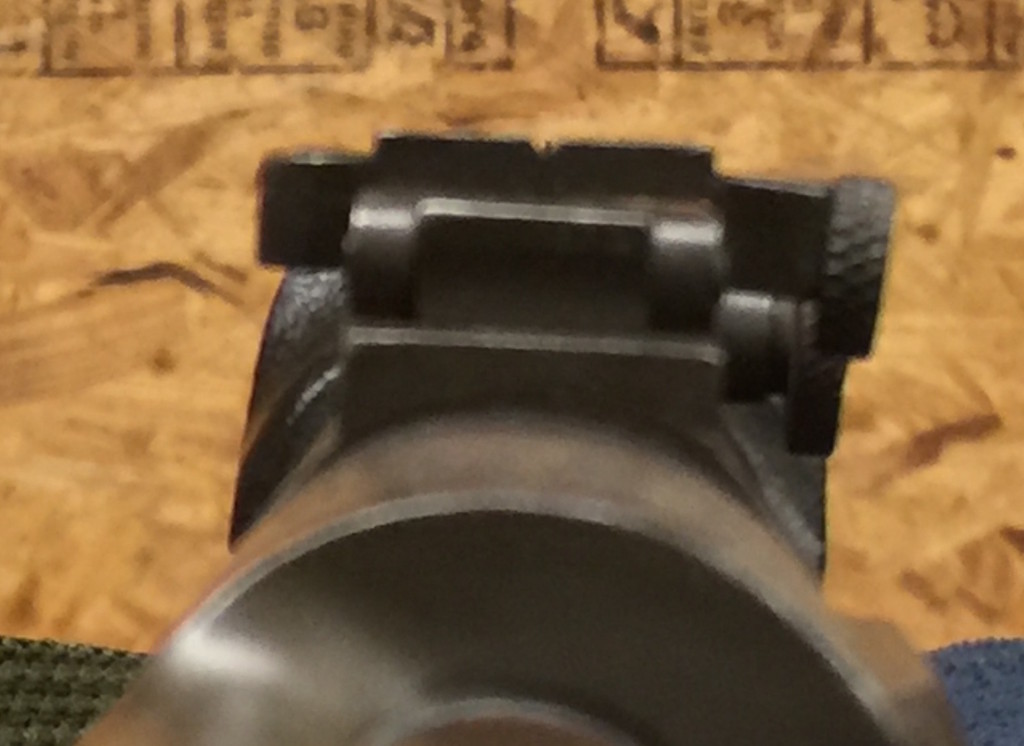
Speaking from experience, when you put up a dirty target on a dirt-colored backdrop, it’s all hopeless. The front blade utterly disappears into the target. Now, the French had a pretty similar setup, although not quite so extreme on their pre-WWI rifles:
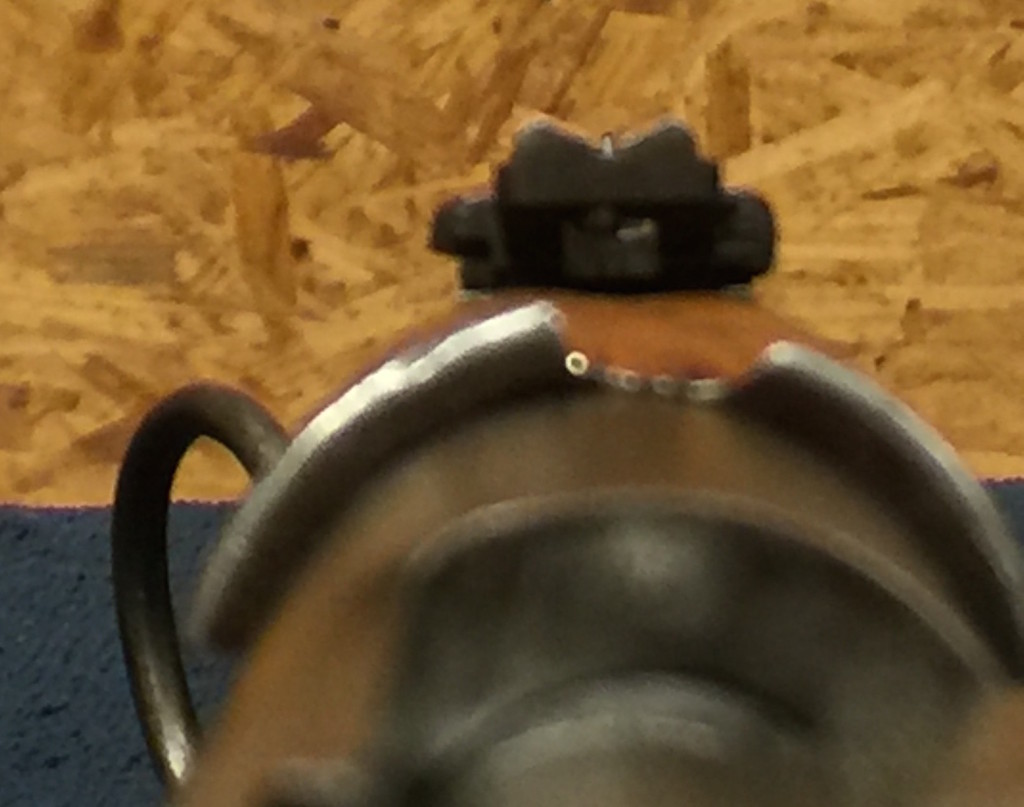
That’s a little better, but not much. Now this is where things get interesting. At some point in 1914 or early 1915, someone with influence in the French ordnance service realized that in real combat you don’t get to take very many slow and deliberate shots at long range – and helpfully stationary – targets. Instead, you often get fleeting snapshots at enemies pretty darn close to you. For that sort of shooting, it’s much more helpful to have a front sight that is fast and easy to acquire, even at the cost of some potential precision.
This notion was (remarkably) acted upon, and in 1915 the French significantly changed the design of their rifle sights, in a way that would have horrified American military experts:
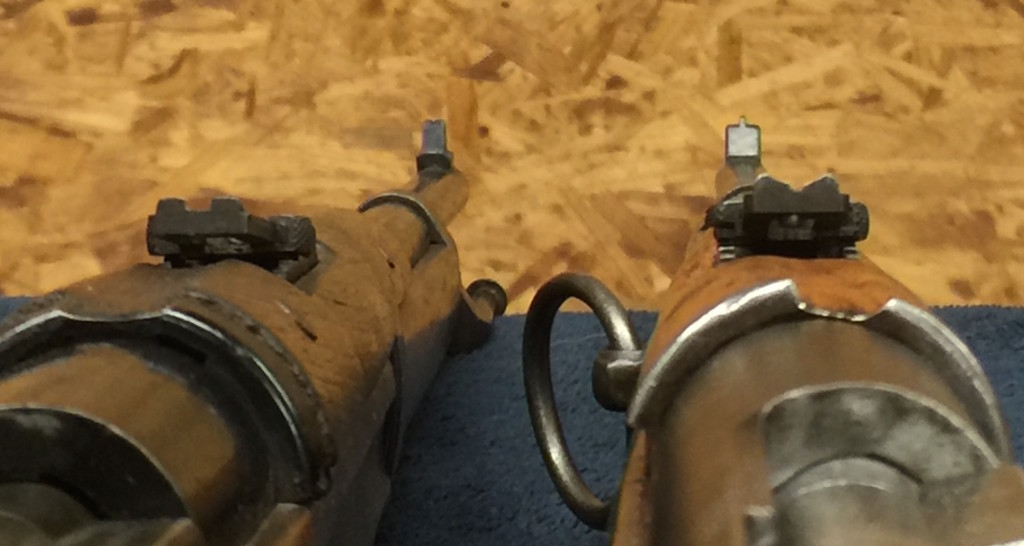
The new front sight was much wider – ridiculously so by American standards, and had a much wider square notch rear sight to match. It’s a bit hard to make out in this photo, but the top of the front post has a small groove cut in its center, which works as a precise aiming point for those shots where careful precision is possible. This new sight design is significantly easier to use in real-world field conditions, as opposed to formal target shooting.
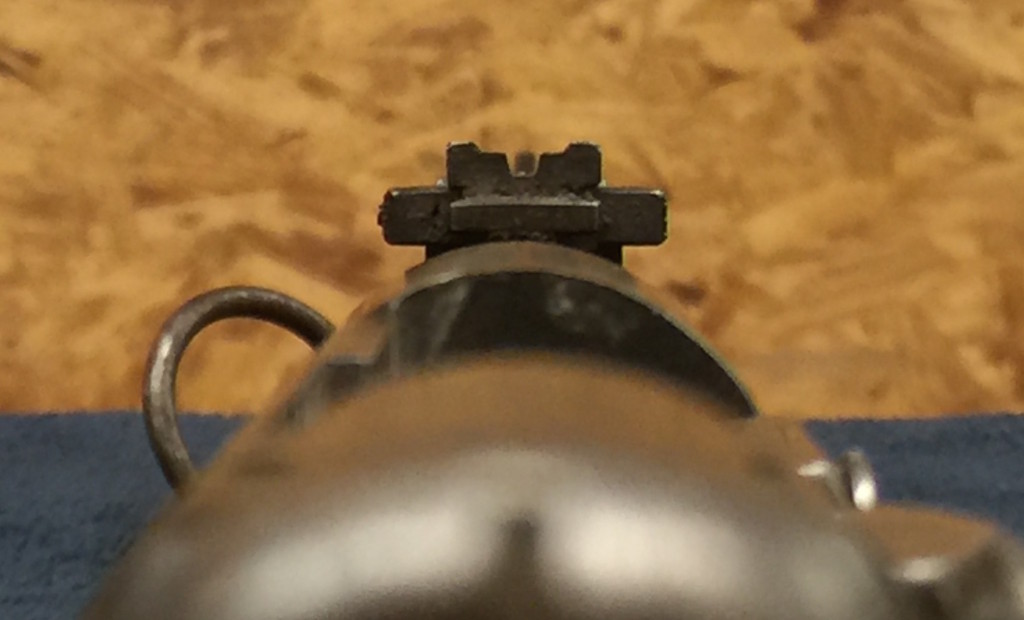
Both the US and the French would transition to aperture sights by WWII, but the basic design philosophy of the sights would remain the same in both countries. The US went to a slightly wider front post for the M1 Garand (although not for the 1903A3 aperture sight), but retained a fully-adjustable rear sight – as necessary for effective match shooting. The French went to an aperture on the MAS-36 bolt action and the MAS-40/44/49/56 series of semiautomatic rifles, and kept them bombproof and as soldier-proof as possible. They were adjustable for elevation only, in increments of 100 meters. For windage adjustment, the rear leaf itself would be completely replaced. A set of rear sights was produced with the sight hole drilled off-center by specific amounts (0.4mm and 0.8mm in all directions).
To zero a MAS-36 or semiauto, an armorer would strap the rifle to a rest, and fire on a target with the different sight settings marked. Hit the center bullseye? Great, no change required (the standard sight was marked with an “N”). Hit somewhere else? Swap the rear sight with the alternative one closest to where you were hitting.
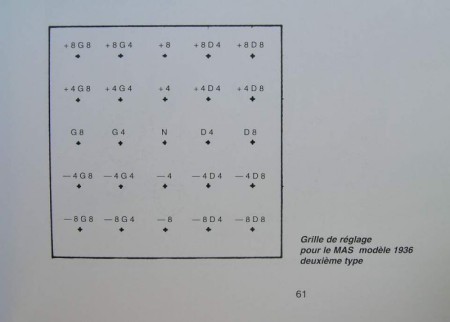
Here, for example, is a rear sight in a MAS-44 which is off-center to the right to correct zero:
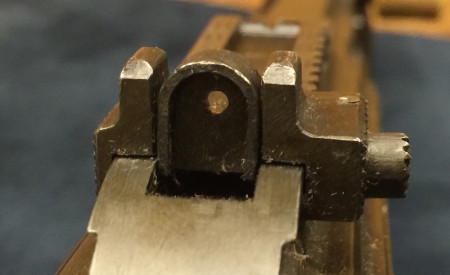
This does not allow a soldier to make precise adjustments to his zero to compensate for wind or fine elevation, true. However, with typical military forces, such adjustments will be accidentally messed up more often than they will be correctly utilized, and the French solution here is a quite practical one. It also has the side effect of making the rifles less expensive to make, by eliminating the many small parts required for minutely adjustable sights.
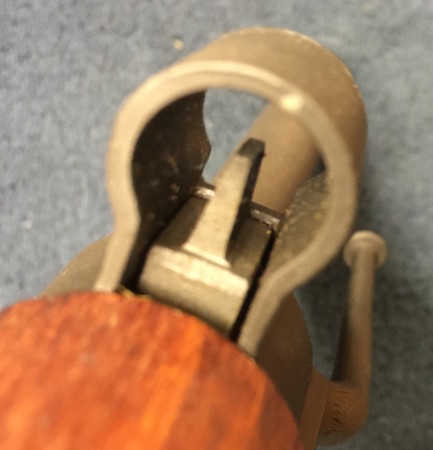

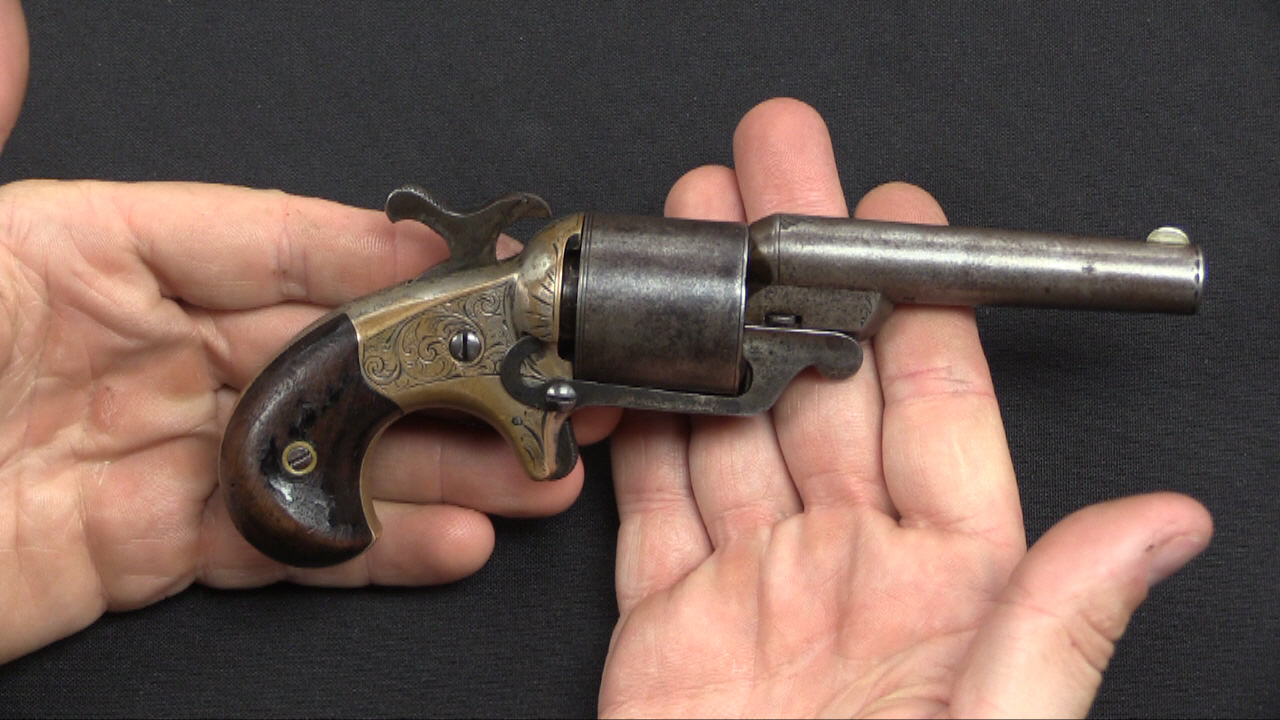

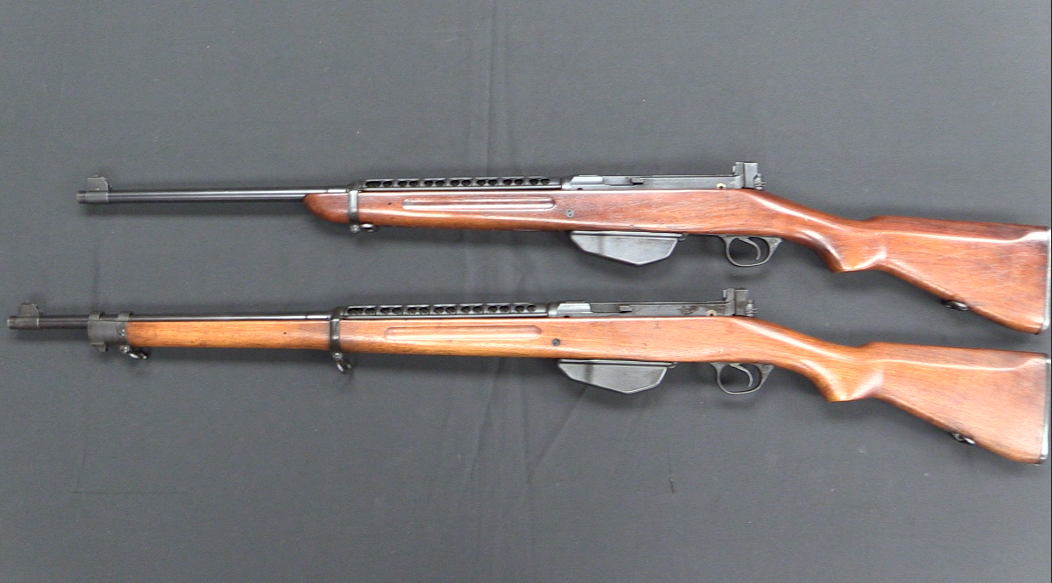
What’s interesting with the post-1915 Berthier sight is that it’s substantially the same as the Lewis sight that was fitted to the early Lee-Metfords and rapidly replaced with a conventional British-style barleycorn setup since the troops really didn’t like it.
It’s “Lewes”, but yes, that pre-dates these.
I recently read Winston Churchill’s early books, from the period where he was actually traveling from one war zone to another as a war corespondent and “drop in” officer… these cover the Malakand campaing of 1897 (northern Pakistan), the reconquest of Sudan 1898, and the 2. Boer war 1899-1900. He was acutally present at, and sometimes took part in, the fighting, and thus gives first hand accounts of the use and effect of the arms of the day. These ranged from Martini Henrys in the hands of the native troops of India and Egypt, to Lee Metford and Enfields.
With reference to sights the interesting bit is how long the ranges of engagement where. Even with the Martini Henrys the firing starts at 500-1000 yards. and in the boer war firefights are maintained at over 1000 yards. Casualties where usually low in these affairs, but forces where frequently pinned or driven back by such fire.
In either case, the soldiers where called upon to fire at targets/target areas at these distances, and a boer war veteran would quite probably feel that he he needed a long range sight.
Brilliant explanation. I was under the impression that many post-15 Berthier sights also had a bit of radium (merci, Madame Curie!) in the tiny slot for use as a luminescent night sight. To my understanding, the only WWI rifle with a luminescent night or low light sight.
Some European gun-writers, particularly Brits, often deride the U.S. obsession with technical marksmanship vs. practical accuracy, e.g. the notorious M1903 rear sight with its aperture and open leaf, etc. vs., say, the Lee Enfield. There was always a disjuncture in WWII between how troops in the U.S. were instructed and the actual conditions of battle in the Pacific and European Theaters. By the 1950s and 1960s, the use of sling-supported shooting, for example, was greatly de-emphasized.
I’ve been looking into what used to be called “fire discipline” vs. “individual marksmanship” or, “field firing.” Thus, there were armies–notably the German–where the typical soldier fired 60 live cartridges, but received all kinds of instruction on firing to particular orders. Imperial Japan might also serve as an illustration.
Yes, night sights were also introduced, although they were not universal, like the large front post style. They can be identified pretty easily; the front post has a round depression drilled in its front face for radium paint, and the rear sight has a pair of similar holes.
Yes, they were not the only ones to use a luminescent sight in WWI. At least the Germans also did do some weapons with radium as well. There’s a beautiful GEW 98 with a luminescent front sight, some kind of muzzle cover (which may be the band for the luminescent sight mount, and trench mag at the WWI Museum in Kansas City if you ever get the chance to go. The front sight design on the rifle is virtually identical to this Luger at RIA, just imagine it on the muzzle end of the front sight blade slightly above the blade. The pictures at RIA are a lot better than my smartphone through the glass at the museum so I leave this here: http://www.rockislandauction.com/viewitem/aid/55/lid/3496
Ah, thanks very much! Those luger add-on luminescent sights are quite a bit like the versions the DDR Nationale Volksarmee devised for the MPiKM Kalashnikov.
The front sight on the Berthier was clearly the basis for the MAS Mle. 1938 7.65mm longue submachine gun’s front sight, albeit with a pair of “flip up” rear aperture sights.
To me, the original Berthier sight setup looks a lot like the American “semi-buckhorn” with narrow center notch plus blade front, seen on Winchester and Marlin lever-actions. It does allow for a fast, “flash” sight picture, plus more deliberate shooting if the opportunity presents itself. (I.e., enemy soldier- or a buck deer- standing still and silhouetted against snow, horizon, etc.)
The later Berthier sight is much like modern “combat” style fixed handgun sights; wide, square-topped front blade and a wider, square-notch rear. Excellent for snap-shooting while retaining a proper sight picture.
The MAS 36 rear sight adjustment system is unusual in arrangement, but not unique in principle. It’s basically the same idea as driving a rear sight left or right in its dovetail to zero a pistol with fixed sights.
A lot of Italian Carcanos and Japanese Arisakas made during the later war years (1942-45) had fixed 100 meter rear sights. This was considered a “wartime emergency” production measure, but it was also probably the designers acknowledging that rifle kills much beyond 100 to 200 meters are a pretty rare occurrence in combat, except for trained snipers. The majority of the killing beyond that range is generally the province of machine guns, mortars, and radios (calling in artillery and/or air support).
Probably the best solution overall was the Russian “battlesight” (reversed “D”) setting on the AK and SKS. With the rear sight at that setting, if you held center chest on the target, out to 300 meters the bullet would hit him somewhere on a vertical line between his shirt collar and his belt buckle. For combat shooting, that’s pretty much good enough with any fighting rifle.
Also, the Russians put the rear sight where it belongs; halfway out the barrel. Those of us without 20/20 vision generally appreciate not having a blurry peep or notch right under our noses.
And guys, especially young ones, with eagle-eyed visual definition generally ended up as fighter pilots, not PBI.
cheers
eon
Well said, eon. Battle weapons really shouldn’t be held to “target weapon” standards if one’s objective is NOT dying (unless one is basically camping the area from a well concealed position with a sniper rifle).
“with a sniper rifle”
If you want to hit target far away with rifle cartridge, you can also get medium machine gun, it fires many times faster, so more bullet per second, so higher chance that some will score a hit. Also it can be used as artillery piece for indirect fire (i.e. set azimuth, set elevation, fire, you don’t need to see enemy), don’t need to reacquire target after each shot as with bolt-action-repeating rifle.
Anyway sights (of M1903 Springfield i.e. common service rifle) scaled to 2700 yards are totally not necessary, can you find enemy in camouflage uniform at that distance without optical instruments?
Carcanos sights were fixed @ 200 meters !
Make that 200 or 300 meters fixed rear sigts; depending on the model.
In the Patrick Hernandez’s (:D) picture :
N = neutre = neutral
D = droite = right
G = gauche = left
C&Rsenal has many sight pictures in a gallery. Click on the link at the top to see them. Great write up Ian.
Any estimates on how wide the post and notch on the post 1915 sights are? Part of me wants to attempt to replicate them on another rifle as I’ve always wondered about larger rifle sights but figured there’s probably a reason why no one ever did it, but it seems someone has done it.
I found a Mas 36 at the local gun store a couple months ago and just had to buy it. Haven’t had a chance to shoot it yet, but I’m favorably impressed with the handling and sight picture. It looks a little clunky and crude, but it seems like a pretty decent, well made and well thought out weapon. Looking forward to some trigger time.
Don’t be put off by the POA/POI issue and the need to find the right sight leaf. It took me a while to figure out, and several changes of leaf, but it is on now… Ammunition can be a chore to find, unfortunately…
Best bolt-action rifle design of WWII, in my view. Had the bore been chromed like the early T99 Arisaka’s, it’d be hands down the best bolt-action, vying with, say, the No.4 Mk.I Lee Enfield!
Starting in August and again in March 1917 Manufacture Nationale d’Armes de Châtellerault (MAC) developed “night sights” for the as-issued front and rear sights, the modification consisted of placing a small amount of fluorescent radium in a small 1/8″ deep rounded hole on the front sight facing the shooter and two on the back of the rear sight leaf,one on each side of the sight notch.
The French actually had been toying with the idea back in the early 1900’s with a clip on front and rear sight for the Fusil de Infanterie Modèle 1886 ‘Lebel’ that had the fluorescent radium in a rounded hole but it was not until the war that they finally found their niche in the usage of them.
Let me explain how to correctly make Sight Adjustments to MAS 36’s ?
Answer: The correct way of adjusting a Mas 36 is by replacing its rear sight leaf by another one with the peep hole drilled off center. There should be a letter or several signs stamped on the top of the rear sight leaf, indicating if it is centered or offset.
Value of offset
N = 0 (centered)
-4 or +4 = bring the group 135mm down or up at 200M
-8 or +8 = bring the group 270mm down or up at 200M
D4 or G4 = move the group 135mm to the right or to the left at 200M
D8 or G8 = move the group 270mm to the right or to the left at 200M
D = Droite / Right, G = Gauche / Left
For the post WWII rifles there are 24 different rear sight leaf available for adjustment beside the N sight and only 8 for the pre WWII models.
The MAS 36 zeroing target you see in the article is a mirror image to be stuck or drawn to the backside of the target to read what offset leaf is required to bring the POA to the POI. Do not put that on the front of the target you will end up going the wrong way.
I have a picture of a target and the correct square blocks drawn on it for adjusting the sights.
Basically you take your usual 100 yards targets you shoot at, draw square blocks on it, depending on the distance you are shooting, 100 yards 2.43″ x 2.43″ or 100 meters 67,5 mm x 67,5 mm and fire away. You shot cluster will indicate the adjustment leaf you need.
Patrick,
thank you for contributing this outstanding description to an already most interesting forum thread.
I actually found this article on the design of post-1915 French iron sights VERY interesting! Keep up the good work!
My 1903 has those tiny sights. They are difficult to see in most conditions, the exception being my basement where I can turn lights on and off.
Ever since watching the first two-gun match online I’ve wanted to try doing the same with my ’03. The ladder sight does, at least, have that large triangle shaped opening to sight through and then fine adjust using the notch at the bottom of the triangle.
Berthier foresight blade .24″
” ”
Notch.024″
Rear sight Notch .10″
Is their any account of a soldier actually using the wind gauge on the M1905 Spfd sight in combat?
I grew up reading how the Spfd sight was so superior which may have been true at Camp Perry but when I actually used it I found it had many flaws.
There was a form of “action” shooting trained for and incorporated into bullseye matches at this time in the U.S., (turn of the 20th century), called the “Skirmish Run.” The difficulty of adjusting the ladder sight during these matches was solved by the precision barrel maker H. M. Pope:
https://books.google.com/books?id=vb3dDN9FiekC&lpg=PA165&dq=united%20states%20rifle%20cal%20.30%20model%201903&pg=PA450#v=onepage&q&f=false
The shooter would have several of these hung by strings, pre-set to the various ranges. A good description of the course of fire:
http://www.odcmp.org/1102/inc_1904.asp
I own a Indian made Lee Enfield that apparently was copied from a WWI era rifle instead of the WWII era British Enfields with “peep”sights. It is chambered in 7.62NATO so I assume it was either reworked or manufactured to meet NATO ammunition requirements. It’s sights are not bad for shooting from a bench but I would hate to need to dispatch an enemy that was moving at anything beyond bayonet range.
The usage of the wider grooved notch front sight goes back to 1886 when the Fusil de Infanterie Modèle 1886 ‘Lebel’ first was adopted but was dropped about 1888 for the smaller narrower type front sights but was later brought back during WWI when they went to this front sight. Finding a “Lebel’ with those early sight is almost impossible unless you have an untouched, un-upgraded one from that early period.
Interesting concept!
https://images.app.goo.gl/ckA9Dm9GxndR1Ra26
The above link has a photo showing the front sight of the French MAS 38 subgun, which is also wide, and has a precision aiming groove as mentioned above.